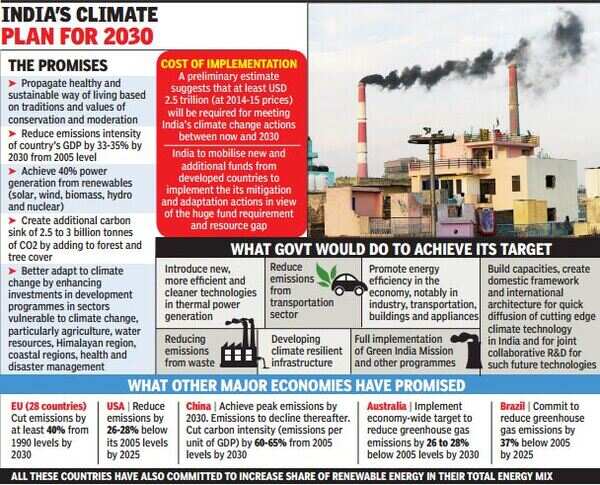- News
- India’s green vow revolves around the Sun
This story is from October 3, 2015
India’s green vow revolves around the Sun
India may have held its ground by not committing to an emission cap and cut plan, or to a peak emission year like China, but the commitments on increasing its non-fossil fuel component of power generation to 40% by 2030 are substantial.

India may have held its ground by not committing to an emission cap and cut plan, or to a peak emission year like China, but the commitments on increasing its non-fossil fuel component of power generation to 40% by 2030 are substantial.
CHENNAI: India may have held its ground by not committing to an emission cap and cut plan, or to a peak emission year like China, but the commitments on increasing its non-fossil fuel component of power generation to 40% by 2030 are substantial.
Given India’s 10% increase in power demand year on year, the nation may have to more than double its installed capacity to 550GW by 2030. The 40% commitment would mean adding at least another 150GW of non-fossil power plants in the next 15 years.
READ ALSO: India's Climate Action Plan ambitious, progressive: Javadekar
India’s pledge document talks about increasing nuclear power from 5 GW to 63 GW by 2032 and doubling wind capacity to 60 GW by 2022.But the most ambitious is the plan to increase solar capacity from 4 GW to 100 GW in the next seven years. With the liability issue bogging down nuclear, much of the heavy lifting may have to be done by solar and, to some extent, wind.

According to a National Institute of Solar Energy estimate, the country has a solar potential of 750 GW, with Rajasthan having the maximum capacity of 142 GW, followed by Jammu and Kashmir at 111 GW. Tamil Nadu’s potential is slightly less than 18 GW. The state has set a target of achieving 3 GW before March 2016 and has made it compulsory for all new high-rise buildings to have solar power units.
The pledge document says: “A scheme for development of 25 solar parks, ultra mega solar power projects, canal top solar projects and 1,00,000 solar pumps for farmers is at different stages of implementation.” The 100 GW expansion planned nationwide would need acquisition of nearly 5 lakh acres of land – at least three times the size of Mumbai.
“Land may be available in some states but the main issue in the coming years will be the cost of land. Government must find land at low cost for companies to put up solar power plants in varying capacities,” former Union energy secretary Anil Razdan told TOI. Besides land, transmission would need to be augmented to evacuate all the new solar power.
Wind and solar power fluctuate, which means the grid would need backup sources and bulk power storage facilities. Razdan stressed the importance of a smart grid and smart substations which will evacuate power and also store it at times. “States endowed with renewable energy sources must have a good forecasting system. Only with better forecasting, there can be right balance of power from various sources,” said Razdan.
Given India’s 10% increase in power demand year on year, the nation may have to more than double its installed capacity to 550GW by 2030. The 40% commitment would mean adding at least another 150GW of non-fossil power plants in the next 15 years.
READ ALSO: India's Climate Action Plan ambitious, progressive: Javadekar
India’s pledge document talks about increasing nuclear power from 5 GW to 63 GW by 2032 and doubling wind capacity to 60 GW by 2022.But the most ambitious is the plan to increase solar capacity from 4 GW to 100 GW in the next seven years. With the liability issue bogging down nuclear, much of the heavy lifting may have to be done by solar and, to some extent, wind.
Solar power has become the catchword for many states in recent times. Internationally, the price of solar power components has been declining at 15% year over year, and states are leveraging this trend to get good deals. Recently, Madhya Pradesh was able to beat down the price it will have to pay for power from a solar project to Rs 5.05 a unit.

According to a National Institute of Solar Energy estimate, the country has a solar potential of 750 GW, with Rajasthan having the maximum capacity of 142 GW, followed by Jammu and Kashmir at 111 GW. Tamil Nadu’s potential is slightly less than 18 GW. The state has set a target of achieving 3 GW before March 2016 and has made it compulsory for all new high-rise buildings to have solar power units.
The pledge document says: “A scheme for development of 25 solar parks, ultra mega solar power projects, canal top solar projects and 1,00,000 solar pumps for farmers is at different stages of implementation.” The 100 GW expansion planned nationwide would need acquisition of nearly 5 lakh acres of land – at least three times the size of Mumbai.
“Land may be available in some states but the main issue in the coming years will be the cost of land. Government must find land at low cost for companies to put up solar power plants in varying capacities,” former Union energy secretary Anil Razdan told TOI. Besides land, transmission would need to be augmented to evacuate all the new solar power.
Wind and solar power fluctuate, which means the grid would need backup sources and bulk power storage facilities. Razdan stressed the importance of a smart grid and smart substations which will evacuate power and also store it at times. “States endowed with renewable energy sources must have a good forecasting system. Only with better forecasting, there can be right balance of power from various sources,” said Razdan.
End of Article
FOLLOW US ON SOCIAL MEDIA
